Conroe Buying Guide: Feeding the Monster
by Gary Key & Wesley Fink on July 19, 2006 6:20 AM EST- Posted in
- Motherboards
General Performance
The PCMark05 benchmark, developed by Futuremark, was designed for determining overall system performance for the typical home computing user. This tool provides both system and component level benchmarking results utilizing subsets of real world applications or programs. This benchmark is useful for providing comparative results across a broad array of graphics cards, CPUs, hard disks, and memory configurations and it also includes some multithreading results. In this sense we consider the PCMark benchmark to be both synthetic and real world in nature while providing consistency in our benchmark results.
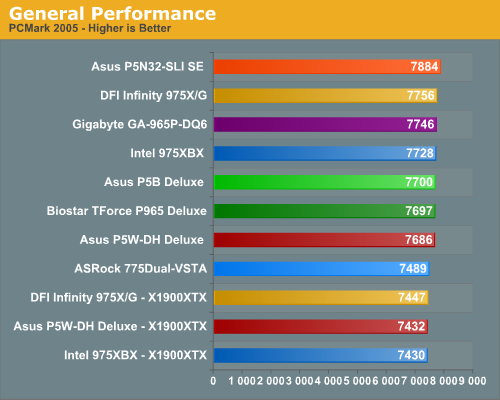
PCMark 2005 results for our test group are fairly close between the Intel chipset boards with the NVIDIA based ASUS P5N32-SLI SE taking a solid lead here due to excellent hard drive performance and multitasking scores within the benchmark. The three ATI X1900XTX equipped boards finished at the bottom of the group due to weak score results in the 2D benchmarks. Despite the close results in these tests with the Intel chipset boards, PCMark05 is still proving to be a useful overall performance benchmark. It is generally more sensitive than the older Winstones and PCMark04 to recent improvements in PC architecture.
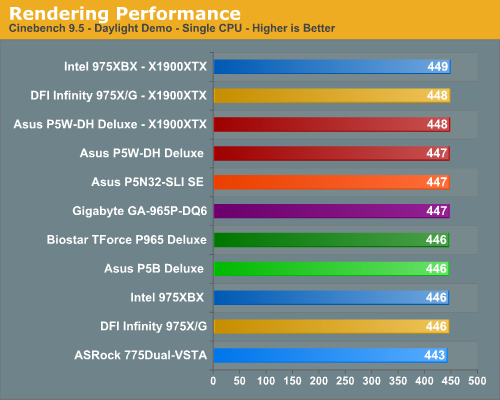
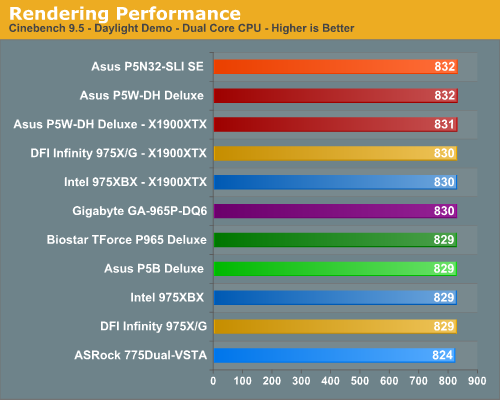
We have replaced Winstones with 2 benchmarks that use rendering to test system performance. Cinebench 9.5 heavily stresses the CPU subsystem while performing graphics modeling and rendering. We utilize the standard benchmark demo within the program along with the default settings. Cinebench 9.5 features two different benchmarks with one test utilizing a single core and the second test showcasing the power of multiple cores in rendering the benchmark image.
While results are generally close in Cinebench, the ASUS P5N32-SLI SE tops the Dual-Core test results with the Intel 975XBX finishing a strong first in the single core tests, followed closely by the ASUS P5W-DH in both tests.
The 3DMark series of benchmarks by Futuremark are among the most widely used tools for benchmark reporting and comparisons. Although the benchmarks are very useful for providing apple to apple comparisons across a broad array of GPU and CPU configurations, they are not a substitute for actual application and gaming benchmarks. In this sense we consider the 3DMark benchmarks to be purely synthetic in nature but still valuable for providing consistent measurements of performance.
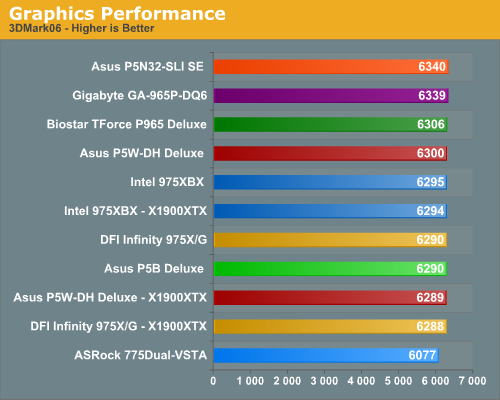
After taking a very strong first place in PCMark2005, we see the ASUS P5N32-SLI SE squeaking out a win in the 3DMark06 with an excellent performance turned in by the Gigabyte GA-965P-DQ6 for second place. The performance of the entire group was very close with the exception of the ASRock board due to its PCIe implementation (although a score over 6000 is still very respectable). The surprise was the ATI X1900XTX GPU scores as they have historically scored better in this benchmark than the NVIDIA based 7900GTX cards. We are still having conversations with ATI, but there appears to be a driver issue with the Core 2 Duo processors in our testing as the game scores will reflect the same results.
Overclocking Comparison
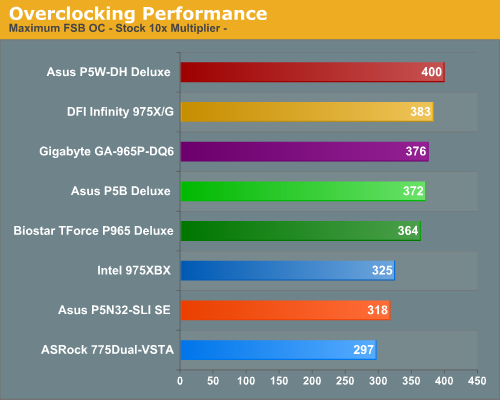
The overclocking capabilities we have measured thus far are with our standard E6700 CPU at a 10X multiplier. While this will not show the true FSB potential of the board, it does show a board's capability with the second highest performing Core 2 Duo and what can be expected with the fixed multiplier CPUs on average. We will be providing FSB overclocking results in our individual board reviews with the unlocked X6800. However, the only board in our testing that exceeded a 400FSB was the ASUS P5W-DH that reached 445MHz with our amazing little E6600 before running out of MCH voltage.
The NVIDIA based ASUS P5N32-SLI SE turned in a decent overclocking performance for an NVIDIA based Intel board but falls far short of the Intel chipset boards in high FSB overclocking. This situation will improve gradually over the next several months with the release of the DFI nF590 SLI board next month and then with the next true chipset revision this winter. Although the nForce4 Intel Edition board did not overclock competitively with the Intel chipsets when utilizing the FSB method, it did match the same overclocks when raising the CPU multiplier with our X6800 CPU.
The PCMark05 benchmark, developed by Futuremark, was designed for determining overall system performance for the typical home computing user. This tool provides both system and component level benchmarking results utilizing subsets of real world applications or programs. This benchmark is useful for providing comparative results across a broad array of graphics cards, CPUs, hard disks, and memory configurations and it also includes some multithreading results. In this sense we consider the PCMark benchmark to be both synthetic and real world in nature while providing consistency in our benchmark results.

PCMark 2005 results for our test group are fairly close between the Intel chipset boards with the NVIDIA based ASUS P5N32-SLI SE taking a solid lead here due to excellent hard drive performance and multitasking scores within the benchmark. The three ATI X1900XTX equipped boards finished at the bottom of the group due to weak score results in the 2D benchmarks. Despite the close results in these tests with the Intel chipset boards, PCMark05 is still proving to be a useful overall performance benchmark. It is generally more sensitive than the older Winstones and PCMark04 to recent improvements in PC architecture.


We have replaced Winstones with 2 benchmarks that use rendering to test system performance. Cinebench 9.5 heavily stresses the CPU subsystem while performing graphics modeling and rendering. We utilize the standard benchmark demo within the program along with the default settings. Cinebench 9.5 features two different benchmarks with one test utilizing a single core and the second test showcasing the power of multiple cores in rendering the benchmark image.
While results are generally close in Cinebench, the ASUS P5N32-SLI SE tops the Dual-Core test results with the Intel 975XBX finishing a strong first in the single core tests, followed closely by the ASUS P5W-DH in both tests.
The 3DMark series of benchmarks by Futuremark are among the most widely used tools for benchmark reporting and comparisons. Although the benchmarks are very useful for providing apple to apple comparisons across a broad array of GPU and CPU configurations, they are not a substitute for actual application and gaming benchmarks. In this sense we consider the 3DMark benchmarks to be purely synthetic in nature but still valuable for providing consistent measurements of performance.

After taking a very strong first place in PCMark2005, we see the ASUS P5N32-SLI SE squeaking out a win in the 3DMark06 with an excellent performance turned in by the Gigabyte GA-965P-DQ6 for second place. The performance of the entire group was very close with the exception of the ASRock board due to its PCIe implementation (although a score over 6000 is still very respectable). The surprise was the ATI X1900XTX GPU scores as they have historically scored better in this benchmark than the NVIDIA based 7900GTX cards. We are still having conversations with ATI, but there appears to be a driver issue with the Core 2 Duo processors in our testing as the game scores will reflect the same results.
Overclocking Comparison

The overclocking capabilities we have measured thus far are with our standard E6700 CPU at a 10X multiplier. While this will not show the true FSB potential of the board, it does show a board's capability with the second highest performing Core 2 Duo and what can be expected with the fixed multiplier CPUs on average. We will be providing FSB overclocking results in our individual board reviews with the unlocked X6800. However, the only board in our testing that exceeded a 400FSB was the ASUS P5W-DH that reached 445MHz with our amazing little E6600 before running out of MCH voltage.
The NVIDIA based ASUS P5N32-SLI SE turned in a decent overclocking performance for an NVIDIA based Intel board but falls far short of the Intel chipset boards in high FSB overclocking. This situation will improve gradually over the next several months with the release of the DFI nF590 SLI board next month and then with the next true chipset revision this winter. Although the nForce4 Intel Edition board did not overclock competitively with the Intel chipsets when utilizing the FSB method, it did match the same overclocks when raising the CPU multiplier with our X6800 CPU.










123 Comments
View All Comments
Vidmar - Wednesday, July 19, 2006 - link
One thing that really bugs me about some of the MB manufactures is that some never state the exact number of PCIe lanes that are actually available on that second PCIe 16x slot. Some do some don’t. Some state it while in SLI/Crossfire mode but not when in non- SLI/Crossfire mode.Right now I’ve got an nForce 4 SLI board that has two PCIe 16x slots, but when in non-SLI mode they are at 16x and 2x respectively. When in SLI mode they are both at 8x respectively.
The problem with this is that (at least on this board) you cannot install anything but a video card in the second PCIe 16x slot when in SLI mode.
I’ve got an PCIe 8x SCSI raid card (LSI 320-2e) that I’m trying to use in the second PCIe slot at 8x, but this board won’t even acknowledge that its there while in SLI mode. And when running in non-SLI it only runs at 2x and becomes a bottleneck for this workstation.
So if its possible to provide some details as to what exactly a board can do on the second PCIe 16x slot in both normal and SLI/Crossfire mode, that would be most helpful!
For example on the ASUS P5W-DH Deluxe in your review it doesn’t state this information either way. But on the Intel 975XBX you do have that information.
So what does the second PCIe slot run at in non-Crossfire mode on the ASUS P5W-DH Deluxe?
Also do you happen to have a SCSI PCIe card you can test in the second slot (or any PCIe card for that matter) and see if the BIOS can recognize the card while in SLI/Crossfire mode? That too would be helpful for people who don’t care about multiple GPUs, but want to create large array workstations.
Thanks!
PS: nice article.
supremelaw - Thursday, July 20, 2006 - link
Excellent points! Constant change is here to stay :)On our ASUS P5WD2 Premium with i955X chipset,
we are now faced with that very same problem:
we don't need 2 video cards, because we do
mostly database development. And, we want
to dedicate the second "universal" x16 slot
to a high-performance PCI-E RAID controller.
(Santa Claus is going to bring me an x1900
PCI-E video card anyway, and that should
easily last me for another 20 years, min!)
Our consultant highly recommends the Areca model,
but it only performs best in x8 mode. On the
other hand, our ASUS User Manual states that
the second "universal" x16 slot can only run
in x4 mode, maximum.
That limitation was a single line of text
in that User Manual, but it is not mentioned
in any of the other specs for our motherboard.
His recommendation: switch to a server motherboard,
so we can use the Areca RAID 6 controller (not a bad
idea, actually).
So, I think we'll have to settle for the Promise
PCI-E model EX8350, which is also limited to x4 mode,
but it now supports RAID 6 too.
It only took about 4 hours of research to confirm
this limitation, however :)
Such specs should be better documented, for sure!
Sincerely yours,
/s/ Paul Andrew Mitchell
Webmaster, Supreme Law Library
http://www.supremelaw.org/">http://www.supremelaw.org/
Missing Ghost - Wednesday, July 19, 2006 - link
I find it weird that the pcie card does not work in 8x mode. I see no reason why it wouldn't work...the sli pcb that you flip around only redirects the lanes AFAIK.vhx - Wednesday, July 19, 2006 - link
Too bad the motherboards cost more than a decent Conroe processor. Kind of sad to see the features lacking until you get into the $250 price ranges. You can spot an AMD AM2 motherboard with the same features for around $130ish, which makes this 975X chipset rediculously expensive compared to the newer AM2's. The TForce P965 looks like a great alternative for the price, although based on the 965P. Hmm upgrading to Conroe will be more expensive than I thought.... /sigh. What to do.Gary Key - Wednesday, July 19, 2006 - link
Wait, that is right, wait until the motherboard suppliers are in full production in August. There will be a large variety of motherboards available by the end of August that will make up the $50~$150 range with chipsets from the 945P to nF570SLI being sold. We will also start seeing the G965 boards in late August for those that want a mATX form factor, decent graphics,and the ability to upgrade later. If you need a board now, it will cost you. ;-)
JarredWalton - Wednesday, July 19, 2006 - link
Not to mention getting the Core 2 CPUs. :) I would expect prices to drop significantly within a month or so.
jonp - Saturday, July 22, 2006 - link
Jarred,Please say more about your comment on pricing.
http://www.dailytech.com/article.aspx?newsid=3377">http://www.dailytech.com/article.aspx?newsid=3377
says:
Thanks, Jon
multiblitz2 - Wednesday, July 19, 2006 - link
I was waiting for the 965 as HDMI/HDCP-support is a must have for my new HTPC. Does 975 support this in the same way as the 965 ?araczynski - Wednesday, July 19, 2006 - link
great article!looking forward to additional mobo's appearing (and more importantly - prices dropping) beforei build my next rig.
i personally refuse to pay over $150 for ANY mobo, no matter the features. but i do realize that the initial price gouging is to milk the early adopters. i figure by early october prices should be just right for all the nice toys.
araczynski - Wednesday, July 19, 2006 - link
i know this is a dead horse, by why in the world can't these manufacturers make models that throw out some of these legacy 'extras' they keep putting on the boards?onboard sound, parallel ports, floppy connectors, etc...